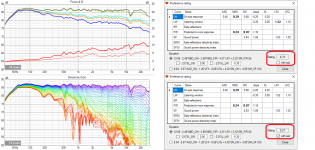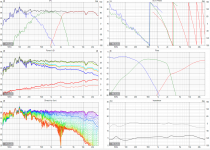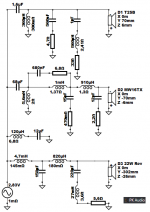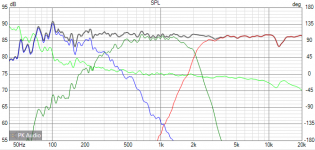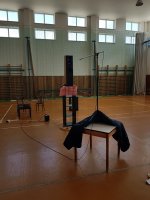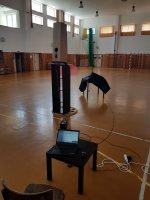MW19 is not bad, you can make a similar shape of cabinet design: Pharaoh-Be | HiFiCompassI would also consider MW19TX, but P version required larger volume compared to MW16, and did not go lower in bass. In that regard MW16 looked optimal. But for TX versions I would need to make cabinet volume modelling again.
I also realized that LR2 with TX versions is hardly possible.
But I personally would prefer the MW16TX.
Today I took measurements 0-18deg, 5deg steps, mic 1m, SPL calibrated, gating 9ms.
There is also graph for all 3 drivers FR at axis, no gating aplied, just 1/12 smoothing.
I attached also distortion measurements. All done at 2,83V.
There is also graph for all 3 drivers FR at axis, no gating aplied, just 1/12 smoothing.
I attached also distortion measurements. All done at 2,83V.
Attachments
-
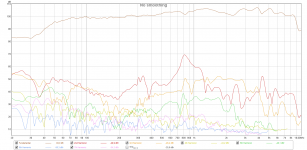 22W4851 2,83V mic30cm.png158.8 KB · Views: 281
22W4851 2,83V mic30cm.png158.8 KB · Views: 281 -
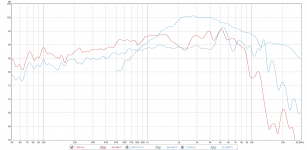 Shamal drivers 1m 1-12smooth.png79.3 KB · Views: 272
Shamal drivers 1m 1-12smooth.png79.3 KB · Views: 272 -
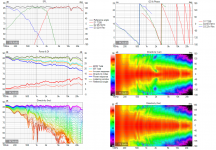 Shamal v6 sixpack.png493.9 KB · Views: 280
Shamal v6 sixpack.png493.9 KB · Views: 280 -
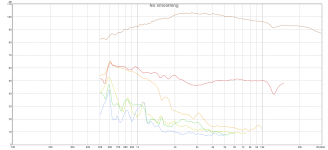 T25B WG 2,83V mic1m.png75.2 KB · Views: 273
T25B WG 2,83V mic1m.png75.2 KB · Views: 273 -
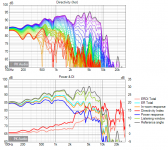 22W H 0-180.png139.3 KB · Views: 262
22W H 0-180.png139.3 KB · Views: 262 -
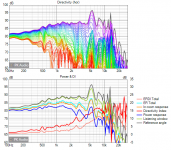 MW16TX H 0-180.png167.1 KB · Views: 130
MW16TX H 0-180.png167.1 KB · Views: 130 -
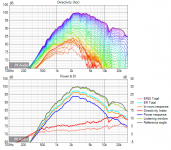 T25B WG H 0-180.png133.6 KB · Views: 111
T25B WG H 0-180.png133.6 KB · Views: 111 -
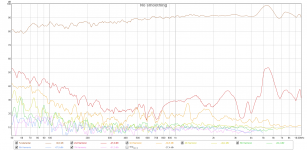 MW16TX 2,83V mic1m.png150 KB · Views: 136
MW16TX 2,83V mic1m.png150 KB · Views: 136
Last edited:
Could you show the preference rating , formula (9), both SL_ON and SL_LW unchecked, with and without sub?
I instaled new vituix version yesterday, so your request came just in time. It will be interesting to check the rating for some non waveguided designs.
Very interesting filters on the mid. I really like what you've done so far. That 13k dip is likely a phase issue from tip of dome to surround.
Interested in seeing acoustical phase. I suspect it will look great judging by the other measurement data.
Interested in seeing acoustical phase. I suspect it will look great judging by the other measurement data.
I attached crossover with blocks description.
Yellow might be omitted, listening tests will tell.
Here it was quite easy and possible to model it without resistors in tweeter and midrange direct paths.
And the graph with minimum phase (green trace).
Yellow might be omitted, listening tests will tell.
Here it was quite easy and possible to model it without resistors in tweeter and midrange direct paths.
And the graph with minimum phase (green trace).
Attachments
Here is current crossover, so far still in modelling phase, but it is close to version I will start with.
Great stuff. It looks like something i'd do myself. I like that you don't shy away from few extra components to linerise phase and frequency response.
There is strong camp these days that you can have nicely controlled response as this only if you are using dsp. Nothing could be further from the truth but it just can't be done with 7 component crossover.
Last edited:
I have to admit I really like simplicity of 3way full LR2 symetric crossover, but in this project it was clear since the beginning that LR2 would not be possible for mid and tweeter.
I usually try to do crossover as simple as possible to achieve desired responses. Every resistor/coil/capacitor that I do not have to use and solder is good as I do not like crossover wiring.
Regarding your note on DSP, I percieve it the same. I try to stay away from DSP as much as I can. Good loudspeaker project starts with a lot of experiments and good acoustic design, diffraction control,.... If this initial phase is done well, all parts just fall in together in modelling phase and result in linear on and off axis responses with minimum issues like diffractions, changes of radiation pattern etc.
I usually try to do crossover as simple as possible to achieve desired responses. Every resistor/coil/capacitor that I do not have to use and solder is good as I do not like crossover wiring.
Regarding your note on DSP, I percieve it the same. I try to stay away from DSP as much as I can. Good loudspeaker project starts with a lot of experiments and good acoustic design, diffraction control,.... If this initial phase is done well, all parts just fall in together in modelling phase and result in linear on and off axis responses with minimum issues like diffractions, changes of radiation pattern etc.
DSP is great way to start and get hands dirty especially before there is confidence on the measurements, in other words few successful projects on the record. Buying bucketful of expensive passive parts needs some confidence, commitment. You seem to have some so it is nice to see such project with good data and explanations and all. Thanks doing it 🙂
Great stuff. It looks like something i'd do myself. I like that you don't shy away from few extra components to linerise phase and frequency response.
There is strong camp these days that you can have nicely controlled response as this only if you are using dsp. Nothing could be further from the truth but it just can't be done with 7 component crossover.
I agree with you 100%. I try to design all my builds without any external processing to accommodate a pure analog signal path. Subwoofer applicationsare the only exception. I have heard a few decent sounding DSP active setups, but they all lack that extra bit of low level detail and attack with acoustic instruments. If it doesnt pass the "piano test", its not for me.
I attached crossover with blocks description.
Yellow might be omitted, listening tests will tell.
Here it was quite easy and possible to model it without resistors in tweeter and midrange direct paths.
And the graph with minimum phase (green trace).
That looks beautiful. Love the outcome and the effort you put into the crossover.
Just out of curiosity I tried to remove gating from measurements and just apply 1/12smoothing.
I have also done "non-gated" measurements with smoothing, down to 1/3 octave smoothing. In the right room environment or outdoors, it can deliver a response similar to the quasi-anechoic response (as you showed).
Back in the old days before we had affordable FFT computer based measurement systems, we would play a CD with 1/3 octave filtered pink noise. We would measure the response with a sound SPL meter and record it in a notebook for later plotting. 30 tracks on the CD covered 20 Hz - 20 kHz. Of course room effects were unavoidable, but with multiple positioning of the mic and speaker, these could be averaged out.... very time consuming... VERY time consuming.
Your lower crossover from the woofer to the MW16TX at around 300 Hz. On my system I originally was crossing to the MW16TX at 160 Hz LR4, but I have since revised it to 200 Hz LR4. The MW16TX has the best midrange performance if it runs above 200 I found.
As I said at the start of the thread, I am very enthusiastic about your project. A really stellar job !
j.
Thank you all for the kind notes.
I attached photos from measurement set. Woofer axis was 2meters above the floor.
Next time I will get some damping material and place it on the floor and in the speaker stand, this may reduce reflections and allow for longer window.
I attached photos from measurement set. Woofer axis was 2meters above the floor.
Next time I will get some damping material and place it on the floor and in the speaker stand, this may reduce reflections and allow for longer window.
Attachments
- Home
- Loudspeakers
- Multi-Way
- New project: 3way 22W/4851, MW16TX-8, T25B in WG
